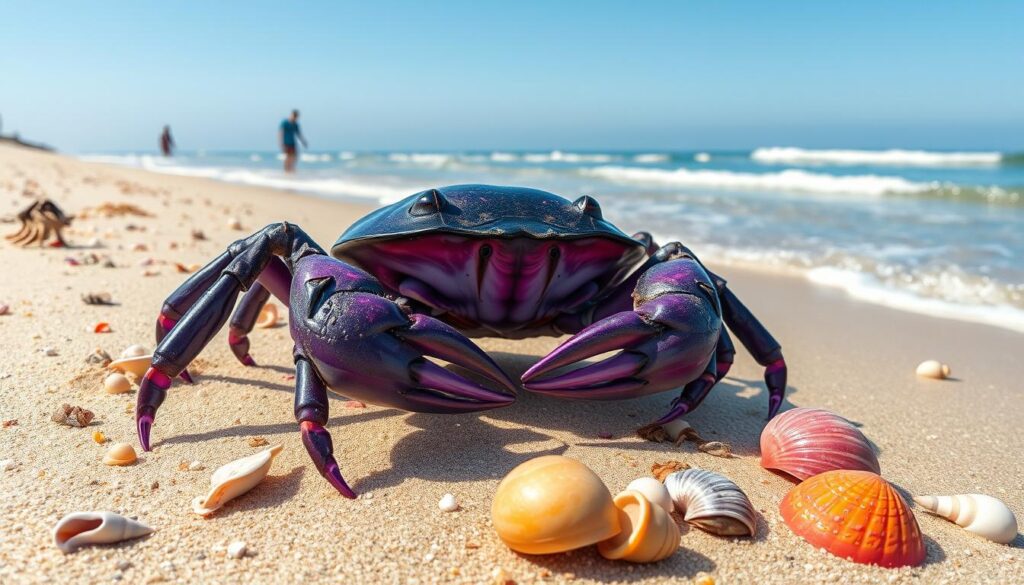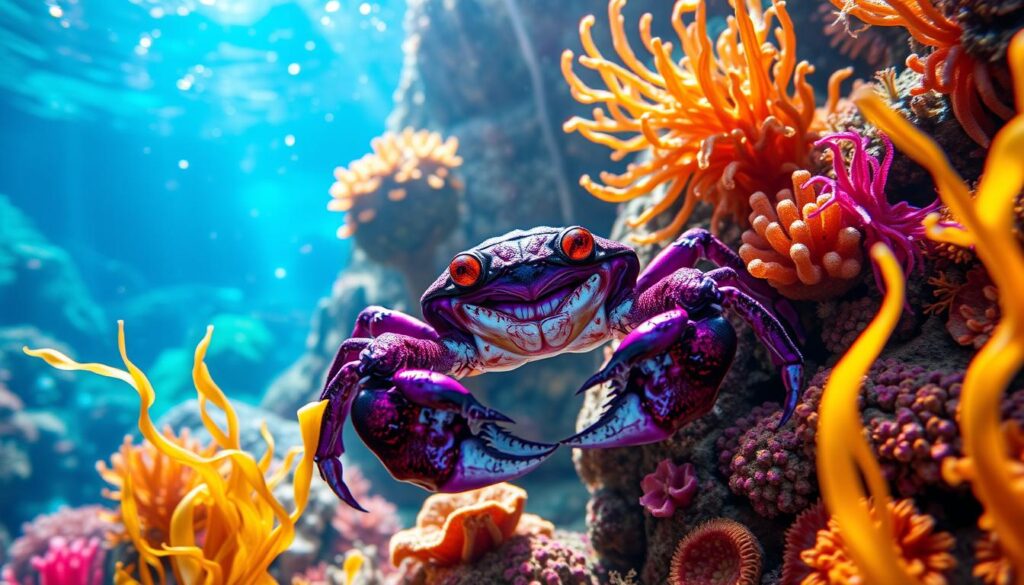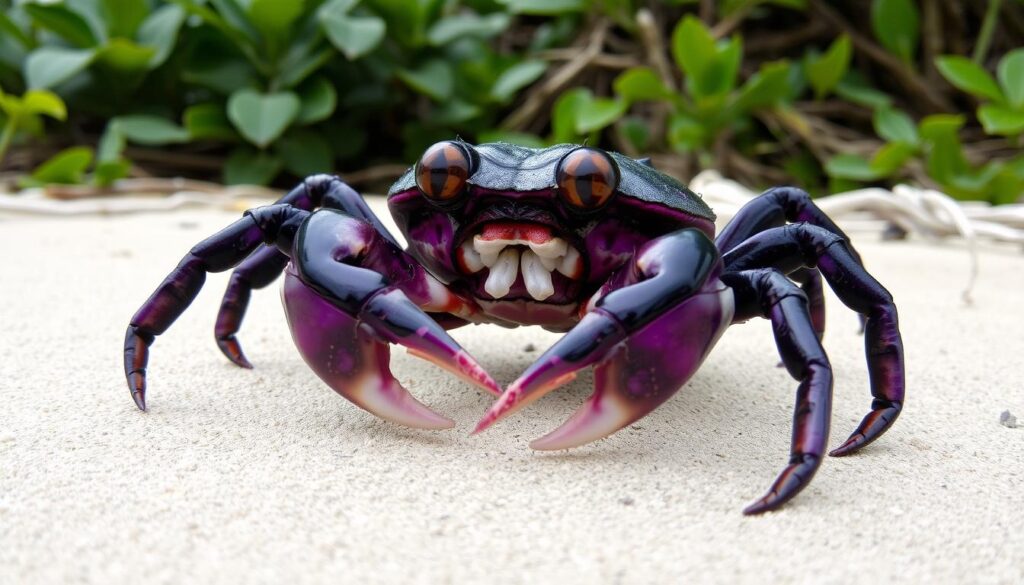Vampir crabs are fascinating creatures that have caught the eye of many. They are a type of crustacean with traits that make them stand out. Marine biologists and aquarium fans are especially interested in them.
We will look into where Vampir crabs live, what they look like, and how they behave. We’ll see why they are so interesting. Whether you love aquariums or just marine life, Vampir crabs will amaze you.

Key Takeaways
- Vampir crabs are a unique species of crustaceans that have gained popularity among marine biologists and aquarium enthusiasts.
- They exhibit distinct physical characteristics and behavior patterns that set them apart from other marine life.
- Understanding the natural habitats and temperature preferences of Vampir crabs is crucial for their care and maintenance.
- Vampir crabs have complex social interactions and require specific tank conditions to thrive.
- By exploring the world of Vampir crabs, we can gain a deeper appreciation for the diversity and complexity of marine life.
Table of Contents
Introduction to the Mysterious Vampir Crab Species
The Vampir crab species is a fascinating crustacean that has caught a lot of attention lately. It has unique traits and interesting behavior. These crabs are important in keeping their ecosystems balanced. To understand them better, we need to look at where they come from, where they live, and how they are classified.
Some key aspects of the Vampir crab species include:
- Origin: The Vampir crab species is believed to have originated in the tropical regions of the world, where they can be found in marine biodiversity hotspots.
- Natural Distribution: These crabs are widely distributed across the globe, inhabiting areas with warm waters and abundant food sources.
- Taxonomic Classification: The Vampir crab species belongs to the family crustacean classification of Xenoglaux, which comprises a diverse range of species.

By studying the Vampir crab species and their role in marine biodiversity, we can appreciate these ecosystems more. Research into their crustacean classification can also help us understand their behavior, habitat, and how to protect them.
| Species | Origin | Distribution | Classification |
|---|---|---|---|
| Vampir Crab | Tropical regions | Warm waters globally | Xenoglaux family |
Physical Characteristics of Vampir Crabs
The Vampir crab has a unique shell shape and coloration that makes it stand out. Their hard exoskeleton protects them from predators. They can also hide well, thanks to their ability to blend in.
Some key features of Vampir crabs include:
- Large, round eyes that are sensitive to light
- A flat, oval-shaped shell with a distinctive pattern
- Powerful claws that are used for defense and food gathering
- A vibrant color scheme that helps them blend in with their environment

Vampir crabs are small, making them perfect for aquariums and terrariums. Their size and unique look make them a favorite among marine animal fans. Their physical traits are a mix of form and function, helping them survive and thrive.
| Characteristic | Description |
|---|---|
| Shell shape | Flat, oval-shaped |
| Coloration | Vibrant, patterned |
| Eye size | Large, round |
| Claw size | Powerful, medium-sized |
Natural Habitat Requirements
To create a good home for Vampir crabs in an aquarium, we need to know what they like. They need the right temperature, humidity, and substrate. In the wild, Vampir crabs live in places with steady temperatures and lots of moisture.
The best temperature for Vampir crabs is between 75°F to 85°F (24°C to 29°C). They also like a humid environment, with humidity levels between 60% to 80%. For digging and burrowing, they prefer a mix of sand, mud, and small rocks as their substrate.
Temperature Preferences
Temperature is very important for Vampir crabs. They do best in temperatures between 75°F to 85°F (24°C to 29°C). Keeping the aquarium at a steady temperature is key to making their habitat feel like home.
Humidity Needs
Vampir crabs need a humid place to live. They thrive in environments with 60% to 80% humidity. To keep the humidity up, you can use a humidifier or mist the tank regularly.
Substrate Requirements
The right substrate is essential for Vampir crabs. A mix of sand, mud, and small rocks lets them dig and burrow. This substrate also helps keep the tank humid and the temperature stable.
By understanding and mimicking the natural habitat of Vampir crabs, we can create a great home for them. The secret to success is keeping the temperature, humidity, and substrate just right, just like their natural marine home.
| Parameter | Ideal Range |
|---|---|
| Temperature | 75°F to 85°F (24°C to 29°C) |
| Humidity | 60% to 80% |
| Substrate | Mix of sand, mud, and small rocks |
The Unique Behavior Patterns of These Fascinating Creatures
Vampir crabs show interesting social behavior. They interact with other sea creatures in their home. They use different signals to talk to each other.
These crabs are known for their marine animal interaction. They live with some fish species. These fish help clean parasites from their shells.
Research on Vampir crab behavior has given us new insights. It tells us about their social behavior, like how they mate and fight for territory. Here are some key points about their behavior:
- They are mostly active at night, hiding in crevices or under rocks during the day.
- They are good climbers, often going up rocks or structures to find food or avoid predators.
- They have complex courtship rituals, showing off colors and movements.
The unique ways Vampir crabs behave make them interesting to study. By learning about their social behavior and marine animal interaction, we can appreciate these amazing creatures more. We also understand their role in the sea ecosystem.
| Behavior | Description |
|---|---|
| Social behavior | Complex communication and interaction with other marine animals |
| Marine animal interaction | Symbiotic relationships with other species, such as fish |
| Nocturnal behavior | Spending most of their time hiding during the day, emerging at night to feed or interact |
Setting Up the Perfect Vampir Crab Terrarium
Creating a Vampir crab terrarium is a fun project that needs careful planning. You must think about the aquarium design and marine tank setup. A good terrarium will make your crabs happy and healthy.
Choosing the right tank size is key. Think about how many crabs you’ll have and their size when they’re adults. A bigger tank means a more stable home for your crabs. You’ll also need a heat source, humidity gauge, and water filter to keep things right.
Tank Size and Setup
A 10-gallon tank is good for a few Vampir crabs. But, a 20-30 gallon tank is even better. Make sure the tank has a deep substrate and decorations that look like their natural home.
Essential Equipment
Here’s what you need for a Vampir crab terrarium:
- Heat source: a heat lamp or heat mat to keep the temperature right
- Humidity gauge: to check and keep humidity at 50-60%
- Water filter: to keep the water clean
- Air pump: for oxygen and air movement
Decorative Elements
Use rocks, plants, and driftwood to make a natural space for your crabs. Live plants help keep humidity up and give your crabs places to hide. A well-made terrarium will be a great home for your Vampir crabs.
| Equipment | Description |
|---|---|
| Heat source | Maintains a temperature range of 75-85°F |
| Humidity gauge | Monitors and maintains a humidity level of 50-60% |
| Water filter | Keeps the water clean and clear |
| Air pump | Provides oxygen and circulation |
Dietary Requirements and Feeding Schedule
Knowing what Vampir crabs eat is key to their care. In the wild, they munch on small invertebrates, algae, and detritus. To keep them healthy in captivity, a balanced diet is vital. Marine animal nutrition is crucial for their well-being.
Here are some feeding tips to remember:
- Commercial pellets should be a main food source.
- Frozen or live brine shrimp, mysis shrimp, or other small invertebrates add protein.
- Fresh veggies like kale or spinach provide essential nutrients.
Setting up a regular feeding schedule is also important. Feed them 2-3 times a week. Only give them as much as they can eat in a few hours.
By following these tips, you can ensure your Vampir crabs stay healthy and happy. Always research their specific marine animal nutrition needs. With the right food and feeding tips, you can create a great home for them.
| Food Type | Frequency | Amount |
|---|---|---|
| Commercial pellets | Daily | As much as they can consume within a few hours |
| Frozen or live foods | 2-3 times a week | 1-2 times the amount of commercial pellets |
| Fresh vegetables | 1-2 times a week | As much as they can consume within a few hours |
Social Behavior and Community Tank Compatibility
Understanding Vampir crab social behavior is key to a peaceful community tank. These crabs are generally calm but can be territorial over food and shelter. It’s important to have lots of hiding spots and visual barriers to reduce fights and stress.
Vampir crabs can live with other calm species that need similar water conditions. Good tank mates include small fish, snails, and other crustaceans. But, make sure to research each species’ needs and behaviors to ensure they get along.
Group Dynamics
In a community tank, Vampir crabs often form small groups. Dominant crabs lead, and they communicate through body language and chemical signals. Watching their group behavior helps you understand their social habits and care for them better.
Suitable Tank Mates
Here are some good tank mates for Vampir crabs:
- Small fish, such as guppies or neon tetras
- Snails, such as nerite or mystery snails
- Other crustaceans, such as shrimp or hermit crabs
Remember, what works for one tank might not work for another. Always check the specific needs and behaviors of each species before adding them to your tank.
Territory Management
To avoid fights in a community tank, manage territory well. Provide lots of hiding spots, visual barriers, and separate areas for each species. By understanding Vampir crab social behavior and community tank compatibility, you can create a thriving and peaceful aquarium. It will showcase the beauty of these fascinating creatures.
Health Monitoring and Common Issues
It’s important to keep an eye on your Vampir crab’s health to avoid diseases. Look for signs of good health like active movement and a strong appetite. But, diseases can happen due to bad water, poor diet, or stress. Keeping the tank clean and feeding them right helps a lot.
Some common health problems in Vampir crabs include:
- Molting issues from bad humidity or temperature changes
- Infections from poor water or open wounds
- Parasites like crustacean lice or protozoa from dirty food or water
To avoid these problems, it’s key to keep the water clean, feed them well, and maintain a clean tank. These steps help keep your Vampir crabs healthy and reduce disease risks.
Knowing about common health issues and taking steps to prevent them helps your Vampir crabs live well. Always put their health first and get help if you see any illness signs.
| Health Issue | Causes | Prevention Strategies |
|---|---|---|
| Molting problems | Inadequate humidity or temperature fluctuations | Regularly check and adjust tank conditions |
| Infections | Poor water quality or open wounds | Perform regular water changes and maintain a clean tank |
| Parasites | Contaminated food or water | Use high-quality food and water, and quarantine new additions |
Breeding and Reproduction Cycles
Breeding Vampir crabs is a complex task that needs careful planning. Marine animal reproduction is a field full of wonder, and Vampir crabs are among the most intriguing to breed. To breed them successfully, it’s crucial to know their reproductive biology and provide the right environment.
Some important factors to think about when breeding Vampir crabs include:
- Water quality and temperature
- Diet and nutrition
- Substrate and habitat
- Sex ratio and mating
Understanding Vampir crab breeding cycles can boost your chances of success. With the right care, these unique creatures can thrive in captivity. Their breeding also helps in conserving this fascinating species.
Breeding Vampir crabs is a challenging but rewarding experience that requires dedication and patience. By following the right guidelines and providing the best possible care, aquarium enthusiasts can help preserve this incredible species for future generations.
Conclusion: Embracing the Joy of Vampir Crab Care
Vampir crabs are truly captivating creatures for those into marine hobby and aquarium enthusiasts. They have unique features and behaviors that make them stand out. These crabs are special additions to any underwater world.
To care for Vampir crabs, you need to know what they need. This includes the right temperature, humidity, and a good home. The tips in this article help you create a great space for your Vampir crab.
Enjoying Vampir crab care means more than just keeping them alive. It’s about understanding and loving their unique ways. By watching their behavior and feeding them right, you can really connect with these amazing creatures.
FAQ
What are Vampir crabs?
Vampir crabs, also known as Red Devil crabs or Vampire crabs, are found in Southeast Asia’s marine environments. They stand out with their bright red or burgundy color and fangs, making them look like vampires.
Where do Vampir crabs live?
These crabs are from the tropical and subtropical areas of Southeast Asia. They live in places like Indonesia, Malaysia, and the Philippines. They prefer coastal mangrove forests, estuaries, and brackish water habitats.
What do Vampir crabs eat?
In the wild, Vampir crabs eat decaying plants, algae, and small animals. In tanks, they can have a mix of commercial crab food, shredded veggies, and sometimes seafood or shrimp.
How do Vampir crabs behave?
Vampir crabs are social and live in groups. They show complex behaviors and territoriality. They are active at night, with their red color more visible in the dark.
What are the care requirements for Vampir crabs?
They need a tank that mimics their natural home. The tank should have moist substrate, be humid, and have hiding spots. The water should be brackish, with specific gravity between 1.005 and 1.015. Lighting should be moderate, and the temperature should be between 72°F and 82°F.
Can Vampir crabs be kept in a community tank?
Yes, they can live with other peaceful animals and fish. But, they might get territorial and aggressive if the tank is too crowded or lacks hiding spots.
How do you breed Vampir crabs?
Breeding them in tanks is challenging but possible. They need specific conditions to breed, like water changes. Creating a rainy season and providing hiding spots for the female are key. Breeding them requires patience and careful attention.
Visit our Instagram page
